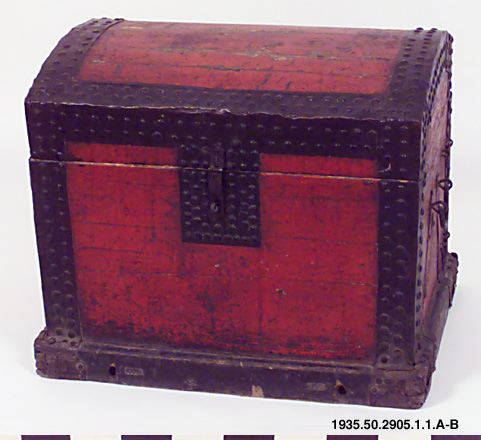Skuggspelsteater vilken består av en scen, figurer, musikinstrument och texter.
Skuggspelsteatern består av fler än 1000 delobjekt. Utförlig dokumentation om skuggspelsteatern och alla dess delobjekt finns i Broman, Sven.1981. (AA)
Skuggspelsteater är en populär form av drama i Kina, och har så varit sedan Sung-dynastien (960-1279 e Kr). Människor från alla samhällsklasser, unga, gamla och framför allt kvinnor ser skuggspelsteatrarnas föreställningar.
Skuggspelsteatern ackompanjeras av tal, recitation, sång och musik. Föreställningen framförs på en scen av träplankor med en skärm av papper från mullbärsträd. Skuggspelsteater framförs av både amatörer och professionella grupper om tre till åtta personer. Vid framförandet står de så att de inte syns från publiken.
Figurerna i skuggspelsteatern kan vara av åsneskinn som behandlats så att det nästan är genomskinligt. En figur består vanligen av elva delar som bundits samman med tråd. Figurerna styrs med tre metalltrådar som fästes vid figurens nacke och båda armar i smala vass- eller bamburör.
Skuggspelsteatrarna skildrar scener ut den folkliga traditionen och kinesisk historia. (Broman, Sven. 1981. s. 13)
"The Ethnographical Museum of Sweden in Stockholm is in charge of an almost complete shadow theatre consisting of more than 1000 pieces (H.2905). It includes the stage as well as figures, musical instruments and texts. In 1931 Dr. Gösta Montell purchased it in Peking and brought it back to Stockholm.
It is a wonderful specimen of the old Peking shadow theatre and of Chinese craftsmanship. The figures are beautifully cut and decorated and almost all are varnished. They were made at the end of the last century and are similar to the famous 'Manchu Prince' collection at the 'Deutsches Ledermuseum' in Frankfurt - am Main.
Dr. Günther Gall says in a letter, dated 24th August 1973: '...since the cutting techique and the ornamentation as well as the colouring are similar, your set may be a piece of work of the 19th century, originating from a school keeping up the traditions of the Manchu Prince'.
As to the varnish of the figures, Dr. Kenzo Toishi, Head of the Department of Conservation Science, Tokyo National Research Institute of Cultural Properties, has kindly given me the following interesting information in a letter, dated the 25th May, 1973:
'...From the sample you sent to me, we took a small part and tested by infra-red absorption method. It was found that the main substance is made or lacquer (URUSHI in Japanese, and in English it is called Japanese lacquer usually) and vegetable oil (perhaps linseed oil). The lacquer is by no means a Japanese one, but seems to have been got from south-east Asia. Black lacquer is usually colored with iron compounds, but we cannot detect iron in this case. Perhaps it was colored with carbon, I think. The environmental condition for hardening of the lacquer seems to have been not adequate - rather dry, because it is still sticky...'
The figures, scenery and props represent a mixture of various styles of art. Many of them show a strong Central- Asiatic influence from the T´ang period in their design and making." (Broman, Sven. 1981. s. 13)
"Skuggspelsteater med musikinstrument och figurer. Jfr. 2892. (MLK)
Foton och teckningar av några av skuggspelsteaterns figurer finns i HBE.








 ARTIKLAR I WIKIPEDIA
ARTIKLAR I WIKIPEDIA ARTIKLAR I WIKIDATA
ARTIKLAR I WIKIDATA BILDER I WIKIMEDIA COMMONS
BILDER I WIKIMEDIA COMMONS








